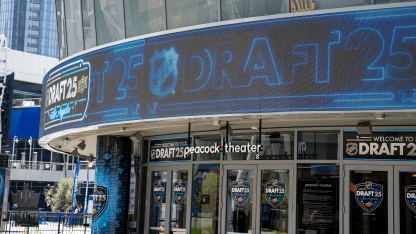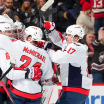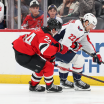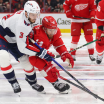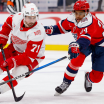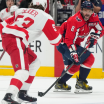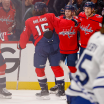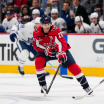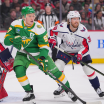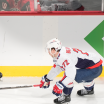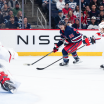This year’s NHL Draft takes place in Los Angeles this weekend, with the first round getting underway at 7 pm Eastern Time on Friday and rounds two through seven unfolding on Saturday beginning at 9 am Eastern Time. In the first year of a newfangled Draft format, the Caps will seek to add some more talent to a stable that has been well restocked with almost two dozen selections – half of them in the first three rounds – of the last three NHL Drafts.
The 2025 NHL Draft takes on a new shape this year; it’s the first “decentralized” Draft the circuit has conducted intentionally in over four decades. From its inception in 1963 through the 1984 Entry Draft, every NHL Draft was conducted in the city of Montreal, typically at the Queen Elizabeth Hotel. In the later years of that Montreal draft monopoly, the Draft was occasionally conducted at NHL headquarters in that fine city, and finally, in 1980, it was opened to the public for the first time and held at Montreal Forum for the first of five straight years.
Beginning in 1985 when it was held in Toronto, the Draft has been a mobile event, hosted by a different NHL city each year. The lone exceptions were the two recent pandemic Drafts of 2020 and 2021; those two Drafts were also decentralized in that each of the League’s teams conducted their portion of the Draft remotely, from their own city.
Potential draftees and their families typically descend on the draft city days ahead of the event, as do scouts, GMs, hockey operations staff, digital staff and PR staff from each of the League’s 32 member clubs. Over the last four decades, the NHL Draft has also doubled as sort of an “unofficial” NHL convention, with over a thousand League and team employees gathering for several days in the host city along with several dozen young draft hopefuls and their agents and families.
By the day before the Draft, one typically can’t walk more than a block or two outdoors without bumping into someone from the League, one of its 32 teams or a member of the media in town to cover the two-day affair.
But everything is different in LA this week. The streets have no extra bustle of NHL types; they’re all back home in their home cities – or the remote location of their choice – where they’ll be able to conduct their business in privacy. After spending about 48 hours in the City of Angels this week, the only hockey people I’ve seen are a couple of media strays and some League personnel, plus a few of the Draft hopefuls roaming the streets with their families.
And instead of conducting the Draft at Crypto.com Arena where the LA Kings play their home games, the 2025 Draft will take place at the Peacock Theater, which has a seating capacity of 7,100 and one of the largest indoor stages in the US.
“We had it during COVID also, so it doesn’t really change it that much,” says Caps assistant general manager Ross Mahoney, who will be conducting his 28th Draft for Washington this weekend, from the team’s MedStar Capitals Iceplex offices in Arlington. “And the sense of how we approach things is no different, but you don’t have the same atmosphere of being on the draft floor with all the other teams, and the media and all the parents in the stands. But as far as we approach it, it’s the same.”
With just five picks in the 2025 NHL Draft, the Caps are looking at their lowest total haul since they called five names in the 2020 NHL Draft. Washington drafted at least seven players – and a total of 22 – in each of the last three Drafts, with half of those 22 selections coming in the first three rounds and from within the top 90 players chosen in those Drafts. For much of the Alex Ovechkin era, the Caps have liberally used their draft capital to make trades and improve the varsity roster. And because they’ve made the playoffs in 16 of the last 18 seasons, the Caps have had few opportunities to select players at the top end of the Draft over that span.
That will be the case again this weekend. Washington’s first-round pick is the 27th overall selection, and it also holds its own selections in the fourth (123rd overall) and fifth (155th overall) rounds. The Caps also hold Boston’s second-round pick (No. 37 from a Feb. 2023 trade of Dmitry Orlov and Garnet Hathaway) and Carolina’s third-round choice (No. 93 from a March 2024 trade of Evgeny Kuznetsov) as a result of a pair of trades involving players from Washington’s 2018 Stanley Cup championship team.
When the Capitals first hoisted the Stanley Cup just over seven years ago, their winning formula was largely comprised of players drafted and developed in house. The team’s top four scorers – Ovechkin, Kuznetsov, Nicklas Backstrom and John Carlson – during that regular season were all first-round Washington draft choices who were developed in the organization after being chosen in the first round of four different drafts two years apart, beginning with Ovechkin in 2004 and concluding with Kuznetsov being drafted in Los Angeles when the NHL Draft was last held here in 2010.
Of the 25 players who saw duty for Washington in the 2018 Stanley Cup playoffs, 15 of them were Washington draftees, four came via the trade route and six were acquired in free agency.
During the 2025 Stanley Cup playoffs, the Caps carried just eight home drafted players, three of which – Ovechkin, Carlson and Tom Wilson – were holdovers from the 2018 championship squad. This past season’s Caps playoff roster also contained nine players signed as free agents and seven more acquired via the trade route.
Mahoney and his amateur scouting staff have done excellent work in hitting on their early picks over the years, enabling the Caps to keep a relatively steady stream of talent coming into their system, which did become a bit barren in the seasons following that Cup win. But of the 10 drafted players who saw duty in 10 or more (regular season and postseason combined) games in 2024-25, seven are aged 25 or younger, and several more promising recent draft choices – as many as eight of them from Washington’s last three drafts – are expected to begin their pro careers this fall.
While Washington’s notable “retooling on the fly” of the last two seasons has been sparked largely by free agent signings and trades for younger players, it got some rocket fuel from 2019 draftees Connor McMichael and Aliaksei Protas, both of whom emerged as top six talents in 2024-25. The hope for Mahoney and the Caps is to add a couple or more top prospects to the stable with those five selections this weekend, in a Draft that many experts see as being somewhat subpar in comparison to other recent classes. But Mahoney has been around long enough to know that every Draft produces quality NHL talent, and while most of it is naturally concentrated at the top, history shows us there are values and good players to be had had throughout the seven-round exercise.
“I think it’s like most years,” says Mahoney of the 2025 Draft class. “There are some quality players for sure that are going to get drafted early in the Draft. I think the top end is fairly good; I think the first round actually is going to be pretty good.”
With two of the top 40 selections and three choices in the first three rounds, Mahoney and the Caps are hopeful of adding a few more young players to a burgeoning group of young talent the team has accrued after being sellers at the 2023 and 2024 trade deadlines.
The Caps will be picking at No. 27 for the fourth time in their history, all in this century. Previous selections in that slot were all blueliners: Jeff Schultz in 2004, Joe Finley in 2005 and the home run selection of Carlson in that slot in 2008, after swapping defenseman Steve Eminger to the Flyers for that pick.
At the No. 37 pick obtained from Boston, the Caps will be choosing for the fifth time. Way back in their first-ever amateur Draft in 1974, that selection was the first pick in the third round. Washington used it on forward John Paddock in 1974, and in 1976 the Caps tabbed forward Tom Rowe – the first American-born player to score 30 or more goals in a season, in 1978-79 – at No. 37 overall.
Many years later, the Caps grabbed defenseman Nolan Yonkman at No. 37 in 1999 and defenseman Ryan Chesley in 2022. Chesley is one member of what is likely to be a sizable class of Washington draftees heading into their first full season in pro hockey in 2025-26.
Back in 2008, the Caps picked Carlson at No. 27 and goaltender Braden Holtby at 93. Both were longtime stalwarts and both were members of the 2018 Cup squad. They’d love to snare a couple more players of that caliber in those same slots this weekend, and they’ll stick to Mahoney’s longtime mantra of taking the best player available on their list whenever their selection comes around.
“We always take the best player available,” says Mahoney. “I know that question comes up all the time, but we really do. If you went by position, you run the risk of saying, ‘Oh, let’s take a defenseman this year; we’re a little light on defense.’ And then a forward goes [with a later pick] and he ends up being a much better player, you’re probably kicking yourself after for not doing that.
“The one year [2006], it was really close, I think, as far as the players, but there were a lot of goaltenders, and we ended up taking [Semyon] Varlamov in the first round. We took Michal Neuvirth in the second round, and we were going to take Steve Mason – I think in the third round. And we had discussed that – [then-GM] George [McPhee] and I – and it was like, ‘We’ve already got a couple of goalies.’ And looking back, we should have taken Steve Mason. He ended up making it. It would have given us another prospect that would either play on our team, or that you can use for trades.
“So we’ve always tried to stick with taking the best player available, unless you’re just splitting hairs. And we really thought that was a strong year for goaltenders. So that would probably be the exception of the 27 drafts that I’ve been through.”
Mahoney and his crew were right about that 2006 Draft being rife with goaltenders. Four were taken in the first round – and there were 26 chosen overall – and both Jonathan Bernier (to Los Angeles at No. 11) and Riku Helenius (to Tampa Bay at No. 15) were chosen ahead of Varlamov, who has played 621 games in the League, more than any of the other 48 netminders in the ’06 Draft.
Mason was the seventh goaltender chosen (No. 69 overall to Columbus, with the sixth pick in the third round), so the Caps must have passed on Mason when they made their second-round pick, opting for defenseman Keith Seabrook at No. 52 overall. But even Columbus could have and should have done better than picking Mason, who was the NHL’s Calder Trophy winner in 2008-09. Mason racked up 205 wins over a 10-year NHL career, but two picks later came a pair of players who played over a thousand games in the League. Boston grabbed Brad Marchand at No. 71 and the Islanders chose Cal Clutterbuck – who recently announced his retirement – at No. 72.
The NHL Draft is an inexact science, but one that has served the Caps well over the years, and especially during Mahoney’s time running the Draft. This weekend’s objective – aside from taking the best player available – is to add at least a couple more prime prospects to the bevy of young talent the Caps have accumulated over the last few drafts.

